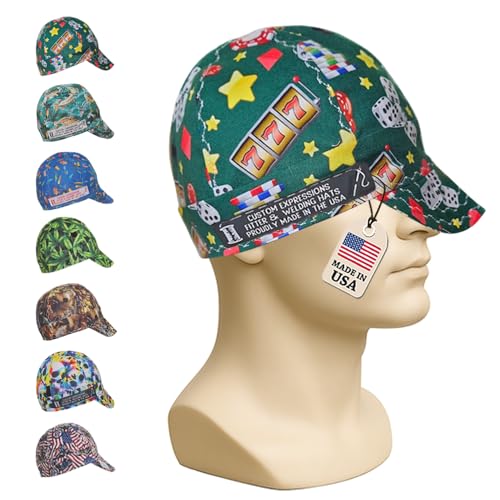Custom welding caps are mainly made for welders as a part of their uniforms. However, it is also a part of our fashion and is made of various prints and designs, keeping this cap’s aim from the beginning. It has been passed from one generation to another for years.
What are Welding Caps for?
People wear welding hats to protect their heads from welding sparks. When a welder turns the bill sideways and over his ear, the hat is there to protect and keep fireballs out of his ear canal.
It is a part of the welder’s uniform. It protects the ear canal and the head, neck, and ears from welding sparks flying around. Also, It provides comfort to the head by saving from the scorching heat.
Some welding caps are absorbent, so they absorb all the sweat from one’s head and prevent it from dripping straight into the eyes. These caps are also made to be fire-retardant.
These days’ people who don’t weld wear customized welding caps because it feels good to wear them under a hard hat. If you want to buy ready-made custom wedding caps, you can check the best-selling products from the list below.
Warning: unserialize(): Error at offset 265 of 265 bytes in /home/newhopepsychology/public_html/wp-content/plugins/aawp/includes/product-helper-functions.php on line 135
Warning: unserialize(): Error at offset 265 of 1397 bytes in /home/newhopepsychology/public_html/wp-content/plugins/aawp/includes/product-helper-functions.php on line 135
Warning: unserialize(): Error at offset 265 of 1397 bytes in /home/newhopepsychology/public_html/wp-content/plugins/aawp/includes/product-helper-functions.php on line 135
Warning: unserialize(): Error at offset 265 of 1397 bytes in /home/newhopepsychology/public_html/wp-content/plugins/aawp/includes/product-helper-functions.php on line 135
What are the Custom Welding Caps Made Of?
Welders are proud of their welding hats undoubtedly. They are soft, backward ball caps that are supposed to be 100% cotton. One should never wear a nylon hat during such hot work as welding. It is very comfortable to wear in the winter. In summer, wearing these caps are an awful experience because the caps do not breathe well. Welding caps that are made of cotton tend to shrink when washed.
What are the Best Welding Caps?
The 7 Best Welding Caps of all time:
- Lincoln Electric Welding Cap – Best Overall.
- Miller Ghost Skulls Welding Cap.
- BSX Welding Beanie – Best Value.
- Comeaux Reversible Welding Cap.
- Lapco 6-Panel Welding Caps.
- BSX Black/Blue Welding Cotton Beanie.
- Revco Cotton Welding-Cap.
N.B. In the above-mentioned 7, the product list contained an Amazon affiliate link where I get a commission for successful selling.
How do you make a Welding Cap?
If you are wondering if you can make a welding cap by yourself- of course you can!
Learn how to make a welding cap by following these steps.
Step 1: The materials that you will need:
- Outer Cloth – about ¼ yard
- Lining Cloth – about ¼ yard
- Batting – Scrap (or fusible interfacing)
- Thread
- Pattern
Step 2: Cut out papers according to your patterns
Step 3: Cut out the fabric following the directions of the pattern. Remember always to measure the shape of the head before cutting the piece.
Step 4: Use a pencil and transfer to mark the patterns from your pattern pieces. The markings will wash away later if you use a pencil or a chalk pencil.
Step 5: Gather all your pieces of fabric after cutting them and assemble them.
Step 6: Interfacing the pieces and clothes. Lay the pieces on an ironing board good side down with an oversized piece of interfacing over all the pieces. Once the interface is set, you can pull it off your ironing board and trim the pieces back down to size.
Step 7: Lay the two lining side pieces on top of each other, right sides together. You must sew a straight line between the two dots you transferred from the pattern pieces. Then, do this procedure again for your outer fabric. After that, press the seams open.
Step 8: Connect the front and the back pieces. Like the sides – lay the two sets of front and back pieces on top of each other. Then sew one side only of each set – stopping at the dots. Continue this process for all 4 groups. Again, press the seams open.
Step 9: Complete the dome by correctly sewing the sections after connecting them.
Step 10: Make the bill.
Step 11: Finish the bill.
Step 12: Connect the Band Pieces
Step 13: Attach Band to Bill
Step 14: Finish the Band
Step 15: Attach the Dome
Step 16: Attach Inner Dome
Step 17: Check Out the Welding Hat
From one generation to another, custom welding caps of various designs and shapes will always live as a part of history in our wardrobes. It will preserve our memories with care.
You may also like:
- Gift Ideas for a 70-year-old man
- Thoughtful Thank you Gift Ideas for Family
- Gifts For The Man Who Has Everything
- Birthday Gift Ideas For Mom from Son
- Most Beautiful Tarot Decks
Last update on 2025-12-16 / Affiliate links / Images from Amazon Product Advertising API






